Different methods, Example, Merits, Limitations, Example Illustration, Solution | Accountancy - Methods of providing depreciation | 11th Accountancy : Chapter 10 : Depreciation Accounting
Chapter: 11th Accountancy : Chapter 10 : Depreciation Accounting
Methods of providing depreciation
Methods of providing depreciation
There are various methods used for providing depreciation on fixed
assets. The management of a business enterprise has to select the most
appropriate method based on the consideration of various factors such as nature
of the asset, use of the asset and circumstances that prevail in the business.
The following are the different methods of providing depreciation:
1.
Straight
line method or Fixed instalment method or Original cost method
2.
Written
down value method or Diminishing balance method
3.
Sum of
years of digits method
4.
Machine
hour rate method
5.
Depletion
method
6.
Annuity
method
7.
Revaluation
method
8.
Sinking
fund method
9.
Insurance
policy method
1. Straight line method/ Fixed instalment method / Original cost method
Under this method, a fixed percentage on the original cost of the asset
is charged every year by way of depreciation. Hence it is called original cost
method. As the amount of depreciation remains equal in all years over the
useful life of an asset it is also called as fixed instalment method. When the
amount of depreciation charged over its life is plotted on a graph and the
points are joined together, the graph will show a horizontal straight line.
Hence, it is called straight line method.
This method is suitable for those assets the useful life of which can be
estimated accurately and which do not require much expense on repairs and
renewals.
Under this method, the following
formulae are used for calculating the amount of depreciation and the rate of
depreciation respectively:

Tutorial note
·
In the year of purchase, if the period of use is
less than a year, the amount of depreciation will be charged proportionately
for the period for which the asset has been used in the business.
·
If depreciation is deducted from the cost of the
asset at the end of useful life of the asset the amount left in the asset
account will be equal to the scrap value if there is any scrap value or it will
be zero if there is no scrap value.
Example
On 1.1.2012, a firm purchased a
machine at a cost of Rs. 1,10,000. Its life was estimated to be 10
years with a scrap value of Rs. 10,000. The amount of depreciation to be
charged at the end of each year is:

When it is plotted on a graph for
5 years, it appears as follows:
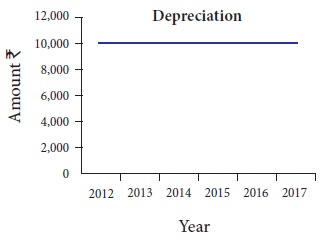
Merits
Following are the merits of
straight line method of depreciation:
(a)
Simple and easy to understand
Computation of depreciation under
this method is very simple and is easy to understand.
(b)
Equality of depreciation burden
Under this method, equal amount of depreciation is debited to the profit and loss account each year. Hence, the burden of depreciation on the profit of each year is equal.
(c) Assets can be completely written off
Under this method, the book value of an asset can be reduced to zero if
there is no scrap value or to the scrap value at the end of its useful life.
Thus the asset account can be completely written off.
(d)
Suitable for the assets having fixed working life
This method is appropriate for the fixed assets having certain fixed
period of working life. In such cases, the estimation of useful life is easy and
in turn it helps in easy determination of rate of depreciation.
Limitations
Following are the limitations of
straight line method of depreciation:
(a)
Ignores the actual use of the asset
Under this method, a fixed amount of depreciation is provided on each
asset by applying the predetermined rate of depreciation on its original cost.
But, the actual use of the asset is not considered in computation of
depreciation.
(b)
Ignores the interest factor
This method does not take into account the loss of interest on the
amount invested in the asset. That is, the amount would have earned interest,
had it been invested outside the business is not considered.
(c)
Total charge on the assets will be more when the asset becomes older
With the passage of time, the cost of maintenance of an asset goes up.
Hence, the amount of depreciation and cost of maintenance put together is less
in the initial period and goes up year after year. But, this method does not
consider this.
(d)
Difficulty in the determination of scrap value
It may be quite difficult to assess the true scrap value of the asset
after a long period say 10 or 15 years after the date of its installation.
Suitability
Straight line method of depreciation is suitable in case of fixed assets
in respect of which useful life can be determined and maintenance and repair
cost is the same throughout the life of the asset.
Illustration 1
On 1.1.2017 a firm purchased a machine at a cost of Rs. 1,00,000. Its life was estimated to be 10
years with a scrap value of Rs. 10,000.
Compute the amount of depreciation to be charged at the end of each year.
Solution

Illustration 2
A company has purchased a
machinery for Rs. 1,80,000 and
spent Rs. 10,000 for
its installation. The estimated life of the machinery is 5 years with a
residual value of Rs. 15,000. Find
out the amount of depreciation to be provided every year.
Solution
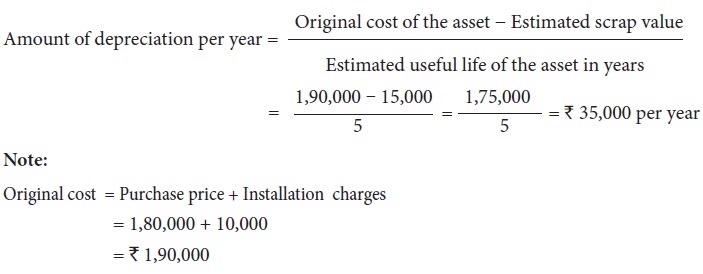
Note:
Original cost = Purchase price +
Installation charges
= 1,80,000
+ 10,000
= 1,90,000
Illustration 3
From the following information, calculate the amount of depreciation and
rate of depreciation under straight line method.
Purchase price of machine Rs.
2,00,000
Expenses to be capitalised Rs.
50,000
Estimated residual value Rs.
15,000
Expected useful life 5
years
Solution
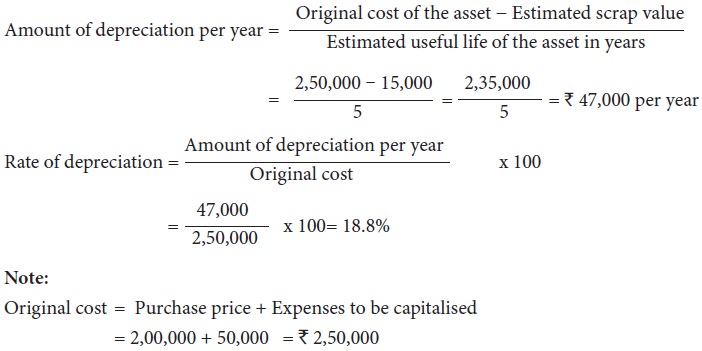
Illustration 4
Find out the rate of depreciation under straight line method from the
following details:
Original cost of the asset = Rs. 10,000
Estimated life of the asset = 10 years
Estimated scrap value at the end = Rs. 2,000
Solution
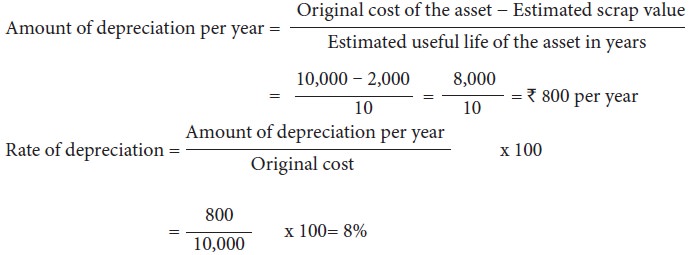
2. Written down value / Diminishing balance method
Under this method, depreciation
is charged at a fixed percentage on the written down value of the asset every
year. Hence, it is called written down value method. Written down value is the
book value of the asset, i.e., original cost of the asset minus depreciation
upto the previous accounting period. As the amount of depreciation goes on
decreasing year after year, it is called diminishing balance method or reducing
installment method.
Example
On 1.1.2012, a firm purchased a
machine at a cost of Rs. 1,00,000. Depreciation charged at 10% p.a. on
written down value method for the five years is as follows:


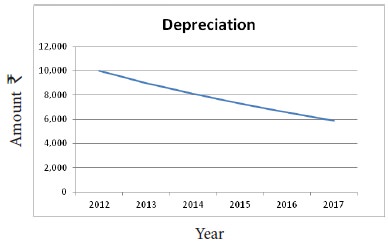
Merits
Following are the merits of
written down value method.
(a) Equal
charge against income
In the initial years depreciation is high and repair charges are low. When the asset becomes older, the amount of depreciation charged is less but repair charges are high. Hence, the total burden on profit in respect of depreciation and repairs put together remains almost similar year after year.
(b) Logical method
In the earlier years, when the asset is more productive, high
depreciation is charged. In the later years when the asset becomes less
productive, the depreciation charge is less.
Limitations
Following are the limitations of written down value method.
(a) Assets
cannot be completely written off
Under this method, the value of an asset even if it becomes obsolete and
useless, cannot be reduced to zero and some balance would continue in the asset
account.
(b) Ignores
the interest factor
This method does not take into account the loss of interest on the
amount invested in the asset. The amount would have earned interest, had it
been invested outside the business is not considered.
(c)
Difficulty in determining the rate of depreciation
Under this method, the rate of providing depreciation cannot be easily
determined. The rate is generally kept higher because it takes very long time
to write off an asset down to its scrap value.
(d) Ignores
the actual use of the asset
Under this method, a fixed rate of depreciation is provided on the
written down value of the asset by applying the predetermined rate of
depreciation on its original cost. But, the actual use of the asset is not
considered in the computation of depreciation.
Suitability
This method is suitable in case of assets having a comparatively long
life and which require considerable repairs in the later years when they become
older. Examples are building and plant and machinery.
Illustration 5
A firm purchased a plant on
1.1.2018 for Rs. 9,000 and
spent Rs. 1,000 as
erection charges. Calculate the amount of depreciation for the year 2018 @ 15%
per annum under the written down value method. Accounts are closed on 31st
March every year.
Solution
Original cost = 9,000 +
1,000 = 10,000
Rate of depreciation = 15%
Date of purchase = 1.1.2018
Number of months used = 1.1.2018 to 31.03.2018 = 3 months
Amount of depreciation = 15% on 10,000 for 3 months
= 10,000 ×15% × 3/12 = Rs. 375
2.1 Differences between straight line method and written down value method
Following are the differences
between straight line method and written down value method
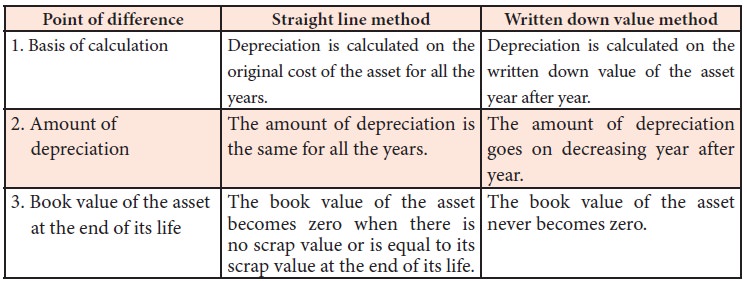
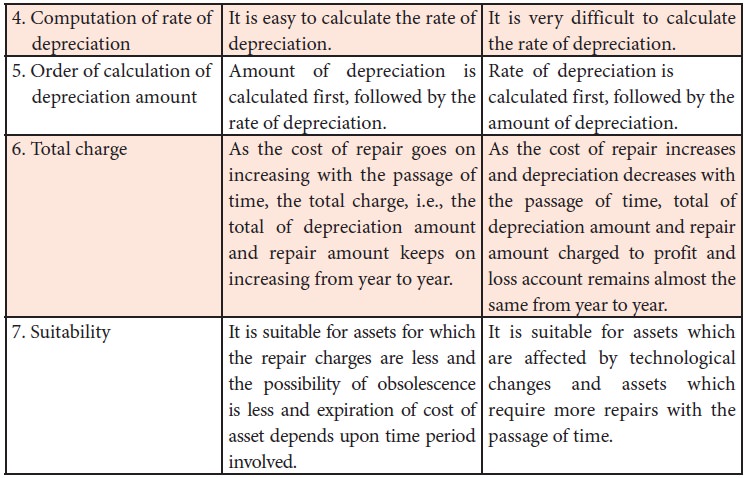

3. Sum of years of digits method
This method is similar to the diminishing balance method. The amount of
depreciation goes on decreasing year after year in proportion to the unexpired
life of the asset. This method is suitable for those assets having more
probability of obsolescence and increased repair charges as the assets grow
older. Under this method, amount of depreciation per year is calculated by
multiplying the cost of the asset and the number of remaining years of life and
dividing it by the sum of the digits of all years of life of the asset. The
following formula is used to compute the amount of depreciation under this
method:

4. Machine hour rate method
Under this method, depreciation per machine hour is calculated. The cost
of the machinery after deducting the residual value, if any, is divided by the
estimated working hours of the machine to find the depreciation per hour. The
actual depreciation for any given period depends upon the working hours during
that year. The special feature of this method is that depreciation is found
directly in proportion to the actual use of the asset. Under this method life
of the asset is estimated in hours and not in years. The following formula is
used to determine the rate of depreciation:

Amount of depreciation = Number
of machine hours used × Rate of depreciation per hour
5. Depletion method
Depletion means exhaustion of natural resources. That is, depletion
means quantitative reduction in the content of assets. This is applicable to
those assets that get exhausted due to extraction and exploitation. Examples:
mines, oil fields, etc. Under this method, depreciation rate is calculated on
the basis of the estimated quantities of the output during the whole life of
the asset.

Amount of depreciation = Units of
output during the year × Rate of depreciation per unit
Note: Even though
it is not depreciated, it is used to write off the cost of the asset as per matching principle.
6. Annuity method
Under this method, not only the original cost of the asset but also the
amount of interest on the investment is taken into account while computing
depreciation. The idea of considering interest is that if the investment is
made in any other asset instead of the relevant fixed asset, it would have
earned a certain rate of interest. To calculate the amount of depreciation,
annuity factor is used. Annuity factor can be found out from the annuity table
or by using formula.
Amount of depreciation is
computed as follows:
Amount of depreciation = Annuity
factor × Original cost of the asset
7. Revaluation method
Under this method, the amount of annual depreciation is calculated by
comparing the value of the assets at the end of the year and their value at the
beginning of the year. The value of the asset at the end of the year is
determined with the consultation of relevant experts. The excess of opening
value over the closing value of the asset is the amount of depreciation for
that year. This method is used for live stock, loose tools, etc.
8. Sinking fund method
This method is adopted especially when it is desired not merely to write
off an asset but also to provide enough funds to replace an asset at the end of
its working life. Under this method, the amount charged as depreciation is
transferred to depreciation fund and invested outside the business. The
investment is made in safe securities which offer a certain rate of interest.
Interest is received annually and reinvested every year along with the amount
of annual depreciation. On the expiry of the life of the asset, the investments
are sold and the sale proceeds are used for replacement of the asset. This
method of depreciation is suitable for assets of higher value. This method is
also known as depreciation fund method. Thus, this method not only takes into
account depreciation but also makes provision for the replacement of the asset.![]()
9. Insurance policy method
Under this method, an insurance policy is taken for an amount equal to
the cost of replacement of the asset. The amount of depreciation is paid by way
of insurance premium every year to the insurance company. On maturity of the
policy, the policy amount is received from the insurance company and it is used
for the purchase of new asset.
Related Topics